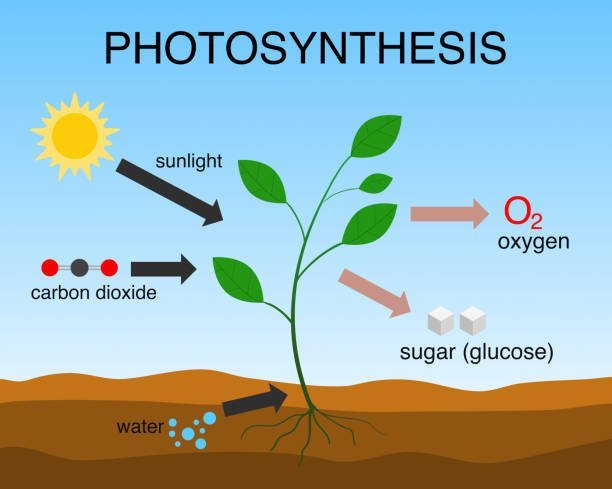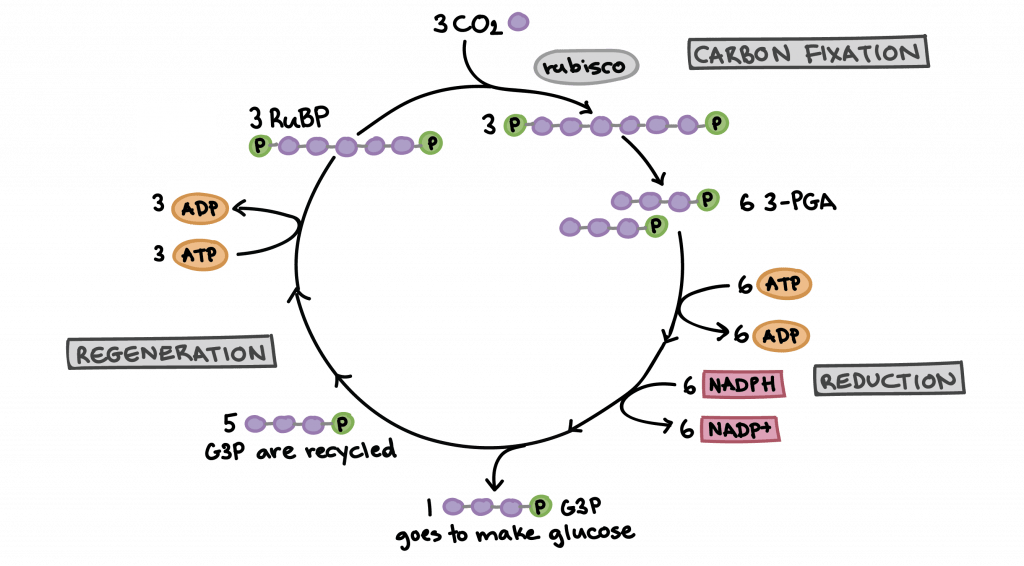Photosynthesis is a key biological process that transforms light energy into chemical energy that is stored in organic molecules. It takes place in plants, algae, and some bacteria. The majority of the planet’s oxygen is produced through this process, which is also necessary for the survival of the majority of living things on Earth.
Chloroplasts, specialized organelles present in the cells of green plants, are where the process of photosynthesis occurs. Pigments that can absorb light energy, like chlorophyll, are found in chloroplasts. These pigments absorb light energy, which causes the transport of electrons and produces a proton gradient that ultimately results in the creation of ATP (adenosine triphosphate). The reduction of carbon dioxide into glucose (sugar) and oxygen is then carried out using the energy from ATP.
The light energy is used to activate electrons in the chlorophyll molecule during photosynthesis after being initially absorbed by the chlorophyll pigments. In the end, a proton gradient is produced across the chloroplast membrane as a result of the transfer of electrons from the chlorophyll to a number of electron carriers. This proton gradient generates an energy source that drives the synthesis of ATP.

The conversion of carbon dioxide into glucose is then fueled by the ATP created during photosynthesis. The Calvin cycle, a series of chemical reactions, is used to achieve this. In the Calvin cycle, ribulose-1,5-bisphosphate, a five-carbon molecule, is mixed with carbon dioxide (RuBP). Two molecules of the 3-phosphoglycerate chemical, which has three carbons, are produced as a result of this process (PGA). Using the energy that ATP provides, a series of subsequent processes transform the PGA into glucose.
The plant uses the glucose created during photosynthesis as a source of energy and as a substance for growth and reproduction. Additionally, some of the glucose is stored as starch in the plant for later use. As a consequence of the process, oxygen created during photosynthesis is released into the atmosphere.
Photosynthesis is a highly efficient process, capturing the energy from sunlight and converting it into usable energy in the form of glucose and oxygen. This process is essential for the survival of most living organisms on Earth, providing the energy and resources needed for growth, reproduction, and survival.
The biological process of photosynthesis, which transforms light energy into chemical energy stored in organic molecules, is so intricate and crucial. It involves the absorption of light by pigments like chlorophyll, which drives the transfer of electrons and the establishment of a proton gradient, leading to the generation of ATP. This process occurs in chloroplasts, which are specialized organelles found in the cells of green plants. The bulk of the oxygen on the globe is created through this process, which is crucial for the survival of the majority of Earth’s living things.
Photosynthesis equation
The equation for photosynthesis can be written as:
6CO2 + 6H2O + light energy → C6H12O6 + 6O2
The overall process of photosynthesis, which takes place in plants and other photosynthetic organisms, is represented by this equation. In the presence of light energy, the reactants carbon dioxide (CO2) and water (H2O) mix to create glucose (C6H12O6) and oxygen (O2).
The transfer of electrons and formation of a proton gradient are fueled by the light energy absorbed by pigments like chlorophyll, which is used to make ATP (adenosine triphosphate). The Calvin cycle, which reduces carbon dioxide into glucose, is subsequently powered by the energy from ATP. The plant uses the glucose created during photosynthesis as a source of energy and as a substance for growth and reproduction. As a consequence of photosynthesis, oxygen is released into the atmosphere.
The equation for photosynthesis is a condensed description of a complicated biological process that is necessary for the survival of the majority of Earth’s living things. It draws attention to how light energy is transformed into chemical energy that is stored in organic molecules and provides the resources required for growth, reproduction, and survival.
Factors Affecting Photosynthesis
Light intensity: Up to a certain point, an increase in light intensity will typically result in an increase in the rate of photosynthesis. Further increases in light intensity may actually slow down photosynthesis after a certain point.
Light color: The pace of photosynthesis might vary depending on the color of the light. The principal pigment in photosynthesis, chlorophyll, is most effective at absorbing blue and red light; green light is absorbed the least effectively.
Carbon dioxide concentration: Up to a certain point, a rise in the concentration of CO2 will often result in an increase in the rate of photosynthesis. Additional increases in carbon dioxide will have little to no impact on the rate of photosynthesis until it reaches a particular concentration.
Temperature: The rate of photosynthesis is affected by temperature, and most plants have a preferred range of temperatures for this process. In excess of this range, either too high or too low, photosynthesis will slow down.
Water availability: Since the stomata (leaf pores) must remain open to allow the exchange of gases, sufficient water is required for the process of photosynthesis. Stomata will close because to a lack of water, slowing down photosynthesis.
Nutrient availability: The pace of photosynthesis can be impacted by the availability of nutrients including nitrogen, phosphorus, and potassium. Lack of these nutrients can affect a plant’s capacity to photosynthesize by limiting its growth and general health.
Atmospheric composition: Changes in the atmospheric composition, such as elevated concentrations of air pollutants or elevated carbon dioxide, might impact the rate of photosynthesis. For instance, high ozone concentrations can harm plant leaves, limiting their capacity to photosynthesize.
Understanding these parameters is crucial for maximizing plant growth and productivity since they can affect the rate of photosynthesis in a variety of different ways.
Light dependent Photosynthesis
The first stage of photosynthesis, during which light energy is transformed into chemical energy, is known as light dependent photosynthesis. In plants and other photosynthetic organisms, this activity takes place in the thylakoid membranes of the chloroplasts.

Light energy is collected by pigments like chlorophyll and other accessory pigments during light-dependent photosynthesis, and this energy is then used to drive the transfer of electrons from water molecules to carbon dioxide. The thylakoid membrane experiences a proton gradient as a result of this transfer, which produces ATP (adenosine triphosphate), the cellular energy currency. The light independent (Calvin) cycle, the second stage of photosynthesis, uses the ATP to drive the transformation of carbon dioxide into glucose.
Photosynthesis is a very effective process that only takes place in the presence of light. The amount of light that is absorbed and transformed into chemical energy relies on the kind and intensity of the light, the presence of water, and other variables that can affect the rate of photosynthesis.
Overall, light-dependent photosynthesis is essential to the process of photosynthesis because it provides the energy required to drive the formation of organic molecules like glucose. The energy and nutrients needed for plants and other photosynthetic creatures to survive and thrive would not be accessible without this mechanism.
Light independent Photosynthesis
The second stage of photosynthesis, commonly referred to as the Calvin cycle and where glucose and other organic molecules are produced from carbon dioxide, is known as light independent photosynthesis. The energy produced during light-dependent photosynthesis is used to power this process, which takes place in the stroma of chloroplasts.

The enzyme RuBisCO fixes carbon dioxide at the beginning of the Calvin cycle, resulting in the formation of an intermediary molecule. Through a sequence of enzyme events including the reduction of carbon dioxide and the creation of energy-rich organic molecules, this intermediate is subsequently utilized to produce glucose and other organic molecules.
Light is not directly required for the light independent photosynthesis process, but it does need the energy produced by light dependent photosynthesis to power the processes. The availability of carbon dioxide, water, and other elements that might influence photosynthesis’ pace all have a role in how much glucose is generated during light-independent photosynthesis.
The plant uses the glucose produced during light independent photosynthesis as a source of energy and as a component for growth and reproduction. Plants and other photosynthetic creatures depend on this process to survive since it gives them the energy and materials they require for development, reproduction, and survival.
Overall, light-independent photosynthesis is an essential part of the photosynthesis process that allows plants and other photosynthetic organisms to transform carbon dioxide into the nutrients and energy required for growth and survival.